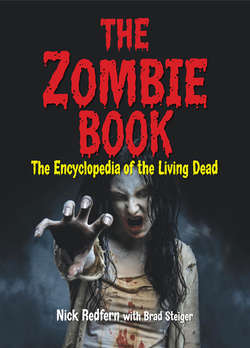Читать книгу The Zombie Book - Nick Redfern - Страница 54
На сайте Литреса книга снята с продажи.
Coffins See also: Burial Traditions, Cemeteries and Tombs, Cremation, Funerals, Mummies
ОглавлениеIf there is one thing that can be said with certainty about the human race, it’s that each and every one of us is on a time limit. Not to be gloomy about it, but sooner or later—and hopefully the latter—we will all shuffle off of this mortal coil. And, when we finally do go, there are two primary options available when it comes to the type of send off we receive. One is cremation and the other is burial in a coffin. But have you ever wondered why coffins have locks on them? Is it, perhaps, due to age-old superstitions and fears that the dead might actually awaken and try to rise from the grave? After all, locking a corpse inside a coffin that is six feet or so underground makes no sense at all. Or, does it? It just might, if there is a fear that the very same corpse may try and force its way to the surface.
Traditions of showing respect to the dead, by doing something beyond simply dumping their bodies for wild animals to feed upon, date back thousands of years. In ancient Egypt, for example, the elite, the rich, and the powerful were carefully wrapped in cloth and placed in a sarcophagus. In Europe, even when civilization was in its infancy, there was an understanding that death was something to honor. Lacking the skills of the Egyptians, the tribes of Europe—and particularly so the Celts—wrapped the average dead person in a sheet of cloth and buried them in the ground. Revered warriors, warlords and kings were placed in coffin-like creations comprised of carefully positioned rocks and stones. In the United States, the coffin industry very much—and very understandably—came to the fore at the height of the American Civil War of 1861 to 1865, in which no less than 600,000 people lost their lives during the carnage of battle.
Have you ever wondered why coffins are firmly sealed? There is, after all, a logical explanation that does not have to do with a fear of zombies.
As for the matter of why, exactly, today’s coffins are firmly sealed on the outside, while the idea that it is done to prevent the zombified dead from digging their way out is an engaging and thought-provoking one, that is not actually the case. In centuries past, such practices were done to prevent grave robbing—which was rife in the United Kingdom, and particularly so in the 1800s. Take, for example, the so-called London Burkers. They were a team of London-based body-snatchers that stole dozens of fresh corpses from graves throughout the nation’s capital during the nineteenth century.
A further, and equally understandable reason for keeping the lid on a coffin is to ensure that if, in a worst-case scenario, the coffin is dropped on its way to burial, the corpse does not tumble out in front of shocked, grieving mourners. And, finally, contrary to popular belief, the coffin is not actually locked. It is simply sealed with what is termed a gasket. Securely fastening the gasket helps prevent water from entering the coffin after it has been placed in the ground. The coffin, therefore, is all about respect for the dead, rather than being based upon age-old fears that the dead might rise from the grave and devour the living. Of course, in the event that a real-life zombie pandemic does one day occur, many will surely sigh with relief that they chose to have their loved ones placed inside a sealed coffin!
